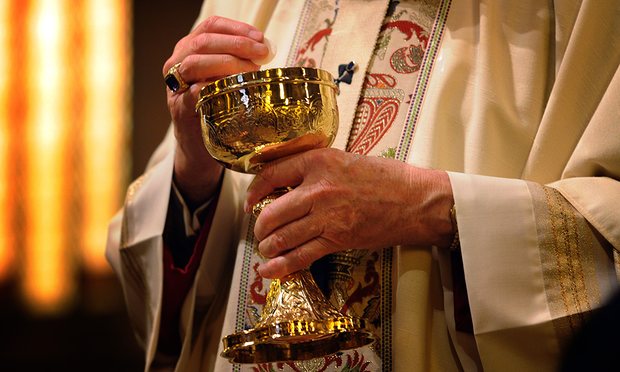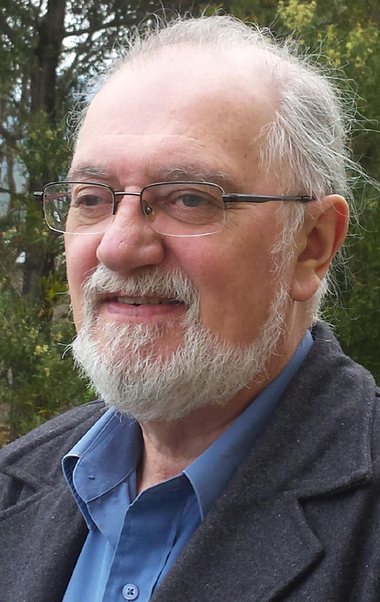"I Went to Bed Screaming': Child Abuse Survivor Speaks As Church Faces Moment of Reckoning
By Christopher Knaus
Every night, as darkness fell around the boarding houses of St Virgil’s College in Hobart, Tony Rayner watched a handful of boys creep into the bedroom of Brother Patrick Timothy Farrell. It was the 1950s and an eight-year-old Rayner was envious of the boys’ special treatment. Rumours drifted through the halls that Brother Farrell’s chosen few were rewarded with lollies. Farrell, a member of the Christian Brothers Catholic order, eventually called Rayner in. “He sat me up on the bed right next to him, and the other boys were down the foot of the bed – when you’re eight years old it was quite a distance,” Rayner told Guardian Australia. “He said, ‘You wanted to come in here.’ And then he told me to suck his dick.”
A confused Rayner said no, telling the brother it would be a sin. He still clearly remembers the odd moment that followed. “He looked at one of the other boys, who I saw as the ringleader … and he said, ‘I told you Rayner was too young.’” A few weeks later, Rayner was ordered into Farrell’s room after lights out, this time alone. Farrell raped him. “I went to bed screaming, still in great pain,” Rayner said. “During the night, I just cried and cried and cried.” After repeated complaints, Farrell was eventually forced out of Tasmania. The children didn’t know it, but he would soon be allowed to begin at another Christian Brothers school in Canberra. It’s a pattern that has emerged countless times during the royal commission’s forensic, four-year examination of the Catholic church. With the commission due to report by the end of the year, the past three weeks have seen that examination move to its final stage. The commissioners are now seeking to understand why clergy abuse occurred on such a massive scale within the church, why the response to complaints was so flawed, and what has been done internally to address the cultural, structural, and governance factors that contributed. A conveyor-belt of witnesses all expressed shock and deep sorrow at the staggering statistics that were produced by the commission’s counsel assisting, Gail Furness, SC, at the outset of this month’s hearing. One in 14 Catholic clergy were accused of abuse by 4,444 victims over six decades. In some individual orders that rate increased to a staggering one in five. The worst order, the St John of God brothers, had 40% of religious brothers accused of abuse. Experts, parish priests, bishops and archbishops have all been asked why the church experienced abuse at such endemic levels. Their testimony has ranged from the profound to the underwhelming. On Thursday some of the church’s most senior leaders in Australia offered arguably their most open criticism of the handling of the abuse crisis. It was “hopelessly inadequate” and “scandalously insufficient”, said Timothy Costelloe, the archbishop of Perth. Anthony Fisher, the archbishop of Sydney, was applauded from the public gallery for saying the church’s response amounted to “criminal negligence”. On Friday Fisher told the hearing in Sydney: “I can’t pretend we have remotely sufficient supervision for me to be assured that they are not misbehaving again.” Yet some within the church’s leadership group are still – after four years of evidence the the royal commission into institutional responses to child sexual abuse, and similar crises in Ireland and the United States – unable to offer insight into an episode that has undermined Catholicism worldwide. The Hobart archbishop, Julian Porteous, was at a loss when asked this week for his explanation. “I do find it very difficult to be able to answer that question, that there was, particularly at some time historically, which was a little bit before my time, a time when this was happening at the rate it was,” he said. “I don’t understand enough of why that was the case. “I struggle to understand why it was so widespread, why there were so many priest perpetrators.” The archbishop of Canberra and Goulburn, Christopher Prowse, was seemingly caught off-guard when asked about the rate of abuse in his former diocese of Sale, in south-eastern Victoria. About 15% of clergy there were accused of abusing children, two times the national average. Prowse was asked what had gone so wrong in that parish. “Well, we’re going back to 1950. I don’t have the statistics on me, but I know that there were some priests there, there were multiple instances there, and I really – I was surprised with that huge statistic and would want to look at it more fully to see how that is the case, yes.” Furness tried again: “You can’t help us any more on your thoughts as to why it might have happened in that diocese where you were bishop for a time?” Prowse responded that possibly priests in rural areas had greater trust from their communities, and were more immature and disconnected than those in the cities. Cardinal George Pell, the most senior Australian in the Vatican and the pope’s prefect of the secretariat for the economy, has appeared before the royal commission on three occasions, once in person and twice via videolink from Rome. He is a former archbishop of Sydney and before that Melbourne, and a former priest in Victoria. When an abuse survivor, Damian De Marco, started campaigning for child protection, he had a sense of optimism. The church and Catholic orders could be turned around, he thought. This month he declared that he had become a sceptic. De Marco was abused when he was a boy at Marist College in Canberra. He was one of many survivors outraged when Prowse failed to show up to a ceremony held by the school to help survivors heal. After Prowse’s evidence this week, De Marco sent a frustrated text. “They are disconnected with reality. How can he not have been listening for four years or seeking his own understanding?” Prowse has since apologised for not attending the Marist ceremony but his actions do not sit well with his claim of wanting to “walk with survivors” in their steps toward healing. The issues that crop up again and again when seeking to understand the Catholic abuse crisis are largely cultural and structural. Celibacy has been discussed at length at the commission hearings, and there have been differing views as to whether it tends to stunt sexual development and maturity in some who practise it. The Brisbane archbishop, Mark Coleridge, one of the most active and knowledgable of the current Catholic leadership on this issue, does not believe it does. Others, such as the Sydney University law professor Patrick Parkinson, told the commission that celibacy, when combined with priests’ emotional isolation, did play a causative role. “It explains the increased risk, which I think is still there, the increased risk of child sexual abuse in the Catholic church community compared to some general level of risk, which is also quite high, in the general population,” Parkinson said. The male domination of the church was also examined. Successive witnesses urged the Catholic church to increase the role of women in leadership, either in lay roles or through changes to canon law to allow for the ordination of women. The commission also considered whether canon law still mandates secrecy and the extent to which the Vatican resists change. Clericalism, the commission has heard, also played a significant role in the pattern of abuse. Priests traditionally held, and continue to hold, exalted positions in their communities. They had power and access to children. Their communities showed them deference and respect, which helped empower abusers and protect them from reprimand. Some of the most powerful evidence on clericalism came from the Parramatta bishop, Vincent Long Van Nguyen, who was applauded by survivors and their families repeatedly during his time on the witness panel. Long, the first Australian bishop of Vietnamese background, was himself abused by clergy when he came to Australia. He spoke of the need to empower parishioners in the affairs of the church. He described a kind of democratisation, a removal of the traditional power imbalance between the ordained and non-ordained. Long decried the superiority conferred on priests through titles, privileges and the church’s institutional dynamics. “People still address me, especially the faithful Catholics, as ‘Your Lordship’ and I sort of cringe at that,” Long said. “Or when they come to see me, or they come to meet me, they kiss my ring. “I’m not very comfortable with those sorts of practices because they encourage a certain infantilisation of the laity and that creation of the power distance between the ordained and the non-ordained. I think we have to look at these things seriously.” The consequences of failing to achieve fundamental structural and cultural change would be dire, not only for the protection of children, but for the fate of Catholic church itself. The Christian Brothers, the order that harboured Rayner’s abuser, shows that through its slow descent into irrelevance. Twenty-two per cent of its clergy were alleged perpetrators, the second highest rate of any religious order in the country. More than 1,000 survivors made a claim against the Christian Brothers. Victims were, on average, 11 years old when they were abused. The Christian Brothers has paid out the most of any Catholic order to survivors, making 763 payments worth $48.5m, an average payment of about $64,000. Its brand is all but gone from Australia, replaced by Edmund Rice Education Australia, an organisation with the Christian Brothers’ founder as its namesake. Christian Brothers’ Oceania leader, Peter Clinch, said there were only 280 brothers left Australia-wide, most of whom were 75 or above. The youngest is 53. They no longer seek new candidates for the order. “It’s a point of contention with our own brothers, but we don’t,” Clinch said. “Some would say that we shouldn’t, which I’m partly in favour of, and there were others that said we’ve folded up the tent too early. “But it’s my opinion that if you look at the statistics and you look at the evidence that is around us, we need to be gracious in our final years and make sure things are in place – for example, Edmund Rice Education Australia – who can do that work effectively and well.” Rayner’s abuse devastated his life. He struggled to hold down a job, lost his beloved wife and daughter, lost his land on Bruny Island and continues to receive counselling. The structure of the church, he says, must change to make it more accountable to the people. “It’s an autocracy and an oligarchy, and that tension between the autocracy and the oligarchy is the only control that they have on it. “They don’t have an ethical restriction coming in, they don’t have a democratic element that says: ‘Little people are really important, and just as important as other people.’”
|
.
Any original material on these pages is copyright © BishopAccountability.org 2004. Reproduce freely with attribution.

